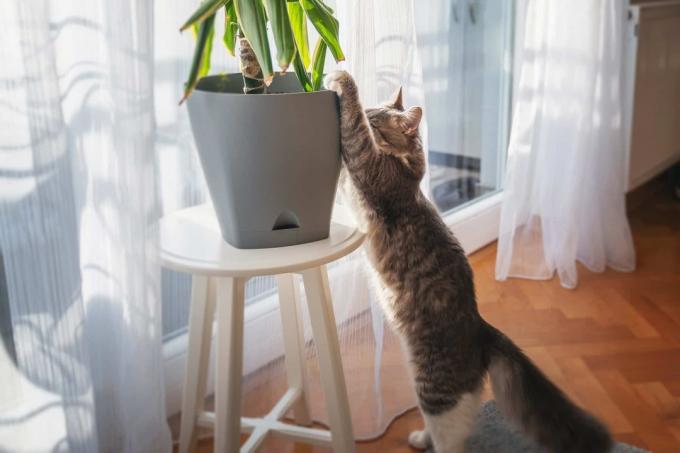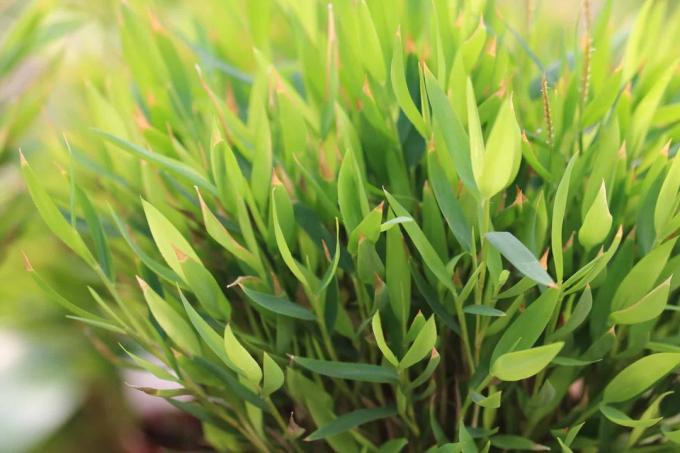
For the cuddly velvet paw, the animal lover is happy to do without some amenities. But an apartment without any green plants does not feel at home. Use these tricks to protect indoor plants from cats.
In a nutshell
- Place plants out of reach, with grids, glass bells, etc. Ä. protection
- Wipe parts of plants with vinegar, spread large stones on soil
- also put peppercorns, garlic and cotton swabs with tea tree oil on soil
- keep bored cats occupied with scratching posts and toys
- Offer cat grass as an alternative
Table of contents
- All houseplants need shelter
- Possible protective measures
- 1. Place pot out of reach
- 2. Find protective shroud
- 3. cover earth
- 4. Deter with scents
- Keep cats busy enough
- Offer cat grass as an alternative
- frequently asked Questions
All houseplants need shelter
Any houseplant can arouse a cat's curiosity and is therefore potentially endangered. Agitated soil, broken pots, torn leaves and broken shoots are some examples of what it can look like after a meeting between a plant and a cat. Not to forget,
Some houseplants are very poisonous to cats and nibbling on it is life-threatening!Tip: If you are unsure whether any of your plants are safe for cats, you should get checked immediately. Poisonous plants should be removed from the house immediately, or at least placed in rooms where cats cannot enter.
Possible protective measures
Cat-proof or protect your plants before a cat moves in. after every new plant purchase. There are several ways to protect indoor plants from cats:
1. Place pot out of reach

Place the plant where the cat cannot reach it. She is safe in a room that she does not enter. Otherwise it will be difficult, because cats are good climbers.
- Put the plant as high as possible
- without adjoining climbing possibility
- a hanging flowerpot is ideal
- find out which surfaces cats don't like to walk on (aluminum foil, etc.) Ä.)
- Prepare pot storage area accordingly
2. Find protective shroud
You can cultivate smaller plants under a protective glass cover. Put others in a decorative cage that keeps the cat at a proper distance. For larger plants, a "cat net" can offer protection, or a special plant protection grid.
3. cover earth
Young kittens in particular are interested in the potting soil, especially since it is easy for them to reach due to its low height. Large stones, shells or aluminum foil spread over it can prevent them from digging or use them as a litter box. If that doesn't help, you can wrap the braid with an elastic material that only has recesses for the shoots.
4. Deter with scents

Most houseplants do not emit a repulsive scent. But you can help! Your options are:
- rub some parts of the plant with vinegar
- Sprinkle soil with some pepper
- alternatively add garlic cloves
- Soak a cotton swab in tea tree oil
- stuck in the ground except for a tip
Keep cats busy enough
Each cat should have at least one scratching post and several toys. Because if she can live out her play instinct to the full, plants are no longer very attractive. So that new stimuli don't tear off, she should be given new toys every now and then. It also helps if her owner plays with her more.
Tip: Clicker training, which is popular with dogs, can also be used here.
Offer cat grass as an alternative

Indoor plants become unappealing when cats get their beloved grass to nibble on. Cat grass can be purchased commercially or easily sown at home become. Seeds of oats, millet, roe or wheat are suitable for this.
frequently asked Questions
First and foremost young and playful cats who want to explore their environment. But even adult cats who are bored indoors like to turn to indoor plants. Then there are those with a sweet tooth who simply want to nibble on everything. Houseplants are less at risk from outdoor cats because they let off steam outside.
Cats don't like plants that have thick, fleshy leaves. These are hardly movable and therefore far too boring to play.
Scolding does not change the behavior of this pet species. Rather, some specimens can be intimidated and react fearfully, while others become aggressive. So you can't protect your indoor plants from your cat in this way. Experts recommend removing the damage promptly and, if possible, without exaggerated gestures or words. Because the cat did not cause the damage on purpose, it rather followed its play instinct.
Even if the cat is fine at the moment, try to find out right away whether the plant you nibbled on is poisonous. Watch out for possible symptoms of poisoning such as apathy, foaming at the mouth, vomiting, tremors or diarrhea. If poisoning is suspected, take the cat to the vet.



